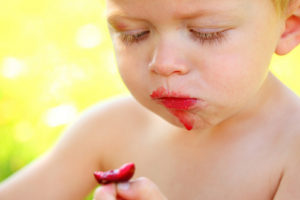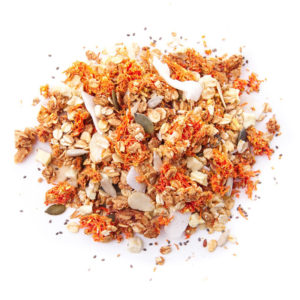
Few of us realise where and when our taste preferences originate – why we prefer sweet to savoury, or when we developed a love or hatred of Brussels sprouts. But research indicates that some preferences reached us through the umbilical cord.
Blog Contents
Tobacco & Alcohol
In our society, there is an increasing awareness amongst women that tobacco- and alcohol-consumption during pregnancy and breast-feeding are not sensible choices.
Sugar & Spice
But when it comes to diet, there appears to be a tendency for the mother to consider that, because she is eating for two, she can eat whatever she wants without consequences for the baby. Sometimes one hears statements like “I’m listening to my body”. But often this really means “I’m listening to my cravings”. There is, of course, a genuine desire to give the baby everything that he or she might need – and without being able to ask the foetus or the newborn for their opinion on the matter, the best the mother can do is to trust her instincts – or more accurately, trust her cravings.
Cravings in Isolation
Cravings don’t exist in isolation. We have to crave something. And what we would hope is that the cravings babies acquire and take with them into adulthood are of the healthier variety – vegetables and beans instead of Big Mac and fries, fresh fruit and nuts instead of ice cream and cake.
Pregnancy & Weening
But what if the mother’s tastes in food during pregnancy and breast-feeding do more than simply satisfy her appetite? What if her indulgence in poor nutritional choices can influence her baby’s taste preferences that could last the rest of his or her life? And we know how difficult it is to change our taste preferences once they have been formed – if you’re in any doubt about this, just try your coffee in a different way from how you prefer it, or when you next have a yearning for something sweet, try to satisfy it with something savoury.
[su_box title=”A treat for one is not necessary a treat for another ” style=”soft” box_color=”#f8f1e8″ title_color=”#07114e”]A traditional Japanese special treat is likely to be something salty.
A modern-day Western special treat is likely to be something sweet.[/su_box]
Research shows that for your baby one of the most important things you can do during pregnancy and breast-feeding is to eat a healthy diet for their health. This is because taste preference appears to start in the womb and continue during early infancy.
Amniotic Fluid Flavour
The foods a pregnant woman eats actually flavour the amniotic fluid the developing foetus lives in.
It literally flavours their environment.
 For example, there was one study where they took pregnant women in the third trimester, and they gave them carrot juice. When the babies started eating cereal, those whose mothers had drunk the carrot juice actually preferred carrot-flavoured cereal!
For example, there was one study where they took pregnant women in the third trimester, and they gave them carrot juice. When the babies started eating cereal, those whose mothers had drunk the carrot juice actually preferred carrot-flavoured cereal!
The baby retained that flavour preference from their exposures in utero.
Bitter/Sweet
Similarly, once a baby is first born, there’s evidence that we have an innate taste for sweetness. Of course, it makes sense that humans should have some form of instinct for this because sweetness often indicates higher calorie density. And our natural inclination to conserve energy would incline us to desire quick fixes of calorie intake.
In a similar way, one would imagine that there must be other sorts of flavours for which we have “built-in” taste aversions, such as bitterness.
A Formula for Taste
Interestingly, though, research into taste preferences in young babies has shown intriguing results when comparing the relative sweetness of cow’s milk formulas with the bitterness of protein hydrolysate formulas, in which the proteins are broken down.
It turns out that the babies getting the protein hydrolysate formulas tended to develop a stronger taste preference for bitterness. And the earlier and longer the exposure to these flavours, the more open the baby is to develop preferences for them later in life.
The Longer The Better
Thus, it’s a better idea to be exposed to healthy foods for two years rather than for just two months, whether the baby is in the womb, being breast-fed, formula-fed or eating from a bowl.
And the research wasn’t just looking at formula-fed babies. It appears that flavours from the food a mother eats change the flavour of the breast milk. So, choices for the mother, whether spicy, sugary or savoury, may become unconscious food preferences for the baby and subsequent adult.
Which Foods?
Early age is the most important stage of life for forming food choices. So which foods are important for pregnant and breast-feeding mothers to consume for their health and, depending on the healthiness of their food preferences, the possible future health of their child?
- As many dark leafy greens as you can (kale, spinach, spring greens, etc) – every day.
- Lots of fresh fruits and vegetables, including starchy veg like potatoes.
- Beans and pulses.
- Whole grains.
- Nuts and seeds.
- Because some plant-based food is a little lower in calorie density than some other food, make sure you’re eating enough and eating regularly throughout the day.
- Avoid vegan junk food – avoid ALL junk food, for that matter.
A Sucker for Sweets
For my part – not as a mother of course, but as a son – I have suspected for many years that my unhealthy preference for all things sweet derived from a similar taste that my mother has always had. Now, having looked at this research, I may be able to trace it even further back than when I first popped my head out into this world.

References:
Beauchamp GK, Mennella JA. Flavor perception in human infants: Development and functional significance. Digestion. 2001; 83(Suppl 1): 1-6.
Julie A. Mennella and Gary K. Beauchamp. Flavor experiences during formula feeding are related to preferences during childhood. Early Hum Dev. Author manuscript; available in PMC 2010 Nov 18. Published in final edited form as: Early Hum Dev. 2002 Jul; 68(2): 71–82.
Mennella JA, Griffin CE, Beauchamp GK. Flavor programming during infancy. Pediatrics. 2004; 113: 840-845.
Mennella JA, Jagnow CP, Beauchamp GK. Prenatal and postnatal flavor learning by human infants. Pediatrics. 2001 Jun; 107(6):E88.
Mennella JA, Johnson A, Beauchamp GK. Garlic ingestion by pregnant women alters the odor of amniotic fluid. Chem Senses.1995; 20: 207-209.
Mennella JA, Beauchamp GK. Experience with a flavor in mother’s milk modifies the infant’s acceptance of flavored cereal. Dev Psychobiol. 1999;35:197–203.
Mennella JA, Beauchamp GK. Developmental changes in the infants’ acceptance of protein-hydrolysate formula and its relation to mothers’ eating habits. J Dev Behav Pediatr. 1996;17:386–91.
Mennella JA, Beauchamp GK. Development and bad taste. Pediatr Allergy Asthma Immunol. 1998;12:161–3.
Mennella JA. Development of the chemical senses and the programming of flavor preference. Physiologic/immunologic responses to dietary nutrients: role of elemental and hydrolysate formulas in management of the pediatric patient; Report of the 107th Conference on Pediatric Research; Columbus, OH: Ross Products Division, Abbott Laboratories; 1998. pp. 201–8.
Laura Scheffler, Yvonne Sauermann, Gina Zeh, Katharina Hauf, Anja Heinlein, Constanze Sharapa, and Andrea Buettner. Detection of Volatile Metabolites of Garlic in Human Breast Milk. Metabolites. 2016 Jun; 6(2): 18. Published online 2016 Jun 6.
Rozin P. The acquisition of food habits and preferences. In: Mattarazzo JD, Weiss SM, Herd JA, Miller NE, Weiss SM, editors. Behavioral health: a handbook of health enhancement and disease prevention. New York: Wiley; 1984. pp. 590–607.
Ray JW, Klesges RC. Influences on the eating behavior of children. Ann N Y Acad Sci. 1993;699:57–69.
Birch LL. The relationship between children’s food preferences and those of their parents. J Nutr Educ. 1980;12:14–8.
Pliner P, Pelchat ML. Similarities in food preferences between children and their siblings and parents. Appetite. 1986;7:333–42.
Burt JV, Hertzler AA. Parental influence on the child’s food preference. J Nutr Educ. 1978;10:127–30.
Rozin P, Fallon AE, Mandell R. Family resemblance in attitudes to foods. Dev Psychobiol. 1984;20:309–14.
Bilkó A, Altbacker V, Hudson R. Transmission of food preference in the rabbit: the means of information transfer. Physiol Behav. 1994;56:907–12.
Domínquez HD, López MF, Molina JC. Interactions between perinatal and neonatal association learning defined by contiguous olfactory and tactile stimulation. Neurobiol Learn Mem. 1999;71:272–88.
Hepper PG. Adaptive fetal learning: prenatal exposure to garlic affects postnatal preferences. Anim Behav. 1988;36:935–6.
Woo CC, Leon M. Sensitive period for neural and behavioral response development to learned odors. Dev Brain Res. 1987;36:309–13.
Rozin P. Human food selection: why do we know so little and what can we do about it? Int J Obes. 1980;4:333–7.
Birch LL. The relationship between children’s food preferences and those of their parents. J Nutr Educ. 1980;12:14–8.
Beauchamp GK, Mennella JA. Annales Nestlé, Nestlé Nutrition Workshop Series. Vol. 56. Vevey: Nestec; New York: Raven Press; 1998. Sensitive periods in the development of human flavor perception and preference; pp. 19–31.
Cook DA, Sarett HP. Design of infant formulas for meeting normal and special need. In: Lifshitz F, editor. Pediatric nutrition: infant feeding, deficiencies, disease. New York: Marcel Dekker; 1982. pp. 71–85.
Schiffman SS, Dackis C. Taste of nutrients: amino acids, vitamins, and fatty acids. Percept Psychophys. 1975;17:140–6.
18. Schmidt HJ, Beauchamp GK. Adult-like odor preferences and aversions in three-year-old children. Child Dev. 1988;59:1136–43.
Van Trijp HCM, Steenkamp JEM. Consumers’ variety seeking tendency with respect to foods: measurement and managerial implications. Eur Rev Agric Econ. 1992;19:181–95.
Pliner P, Loewen ER. Temperament and food neophobia in children and their mothers. Appetite. 1997;28:254–89.
Schuett VE, Gurda RF, Brown ES. Diet discontinuation policies and practices of PKU clinics in the United States. AJPH. 1980;70:498–503.
Schuett VE, Brown ES, Michals K. Reinstitution of diet therapy in PKU patients from twenty-two clinics. AJPH. 1985;75:39–42.
Hogan SE, Gates RD, MacDonald GW, Clark JTR. Experience with adolescents with phenylketonuria returned to phenylalanine-restricted diets. JADA. 1986;86:1203–7.
Snyder LH. Inherited taste deficiency. Science. 1931;74:151–2.
Mennella JA. Taste and smell. In: Swaiman KF, Ashwall S, editors. Pediatric neurology: principles and practice. 3. Philadelphia, PA: CV Mosby; 1999. pp. 104–13.
Duffy VB, Bartoshuk LM. Food acceptance and genetic variation in taste. J Am Diet Assoc. 2000;100:647–55.
Drewnowski A, Henderson SA, Barratt-Fornell A. Genetic taste markers and food preferences. Drug Metab Dispos. 2001;29:535–8.
Mattes RD. Learned food aversions: a family study. Physiol Behav. 1991;50:499–504.